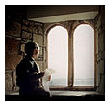
Alpha and Omega are also numbers (5)
Posted by Moderator on Apr 14, 2011 in Mathing | 0 commentsTraditionally the last words of John the beloved disciple were ‘Little children, love one another.’ It seems a likely story because, after all, he says just that so often in his epistles.
However, it’s worth remembering that Jesus gave him and his brother James the nickname Boanerges, usually translated Sons of Thunder, but perhaps more correctly rendered sons of rage. So the story that he grabbed his clothes and fled the public baths when he realised the Gnostic teacher Cerinthus was in the same building, just in case God’s wrath was about the turn the place to a cinder, is not altogether far-fetched.
The gospel of John was, in the second century, of uncertain status. Helms points out that some Christians believed it had been written by the apostle as an anti-gnostic anti-Cerinthian work while others considered it had been written by Cerinthus himself!
Was the muddle not because of theology but mathematics? In clear defiance of Cerinthus’ claim that Jesus was flesh but Christ was spirit, John’s gospel says the Word became flesh. Yet the mathematics shares much in common with the Pythagorean mysticism prevalent among the Gnostics.
For a start, the arithmetic architecture includes 496, both ‘perfect’ and ‘triangular’. Then there’s that number adored by Platonists and Pythagoreans of later centuries—the logos—which today we term the ‘golden ratio’.
On the other hand however, there’s 153—a number any Pythagorean of good taste found abhorrent—used so prominently in John 21:11 when Jesus prepares breakfast for his disciples.
Some people might protest John was an illiterate fisherman from Galilee. How could he have used a mathematical design that most people of today find challenging? The fact is even ‘illiterate’ Galilean fishermen of the first century had an education that involved learning the Torah—the first five books of the Bible—off by heart. Those who were a little more educated knew the Prophets by heart as well. So even relatively uneducated people could recite the whole of the Old Testament. And, as previously noted, from the scribes they knew there was a deep mathematical structure to Scripture.
So, quite apart from the fact that John would have wanted his gospel to be taken seriously and thus needed to keep to accepted canons of good literature (including numerical literary style), he obviously had a big incentive to score points off the Pythagoreans.
He starts with the Logos. This Greek term is much more than the traditional translation suggests. Besides Word, it also means reason, mind and rationality. Sometimes it is suggested that Logos would be better translated as Expression. All of these are valid, but they all overlook the fact that Logos also has a mathematical sense. It means ratio or proportion. When it is the ratio, the logos, it is not any old proportion but a very special one: the ‘golden ratio’.
Open your eyes and it’s a mathematical design found everywhere. It’s God’s signature for Himself as creator. The tendency towards the golden ratio is found in places as diverse as galaxies and seashells, bananas and pawpaws, starfish and comets, starfish and apple cores. It’s been discovered in the design of hydrogen atoms as well as within the operation of human freewill.
As a number it’s approximately 0.61803398874989484820458683436564 which, when multiplied by 496 and rounded, gives an answer of 306.5. Multiply 306.5 by 2 and the answer is 613, the number of laws in the Torah. Divide it by 2 and the answer is 153, the size of the miraculous catch of fish on the occasion of Jesus’ third appearance to His disciples after His resurrection.
Brilliant! Prologue and epilogue: there’s so much more to John’s design than just 496 for its own sake.

